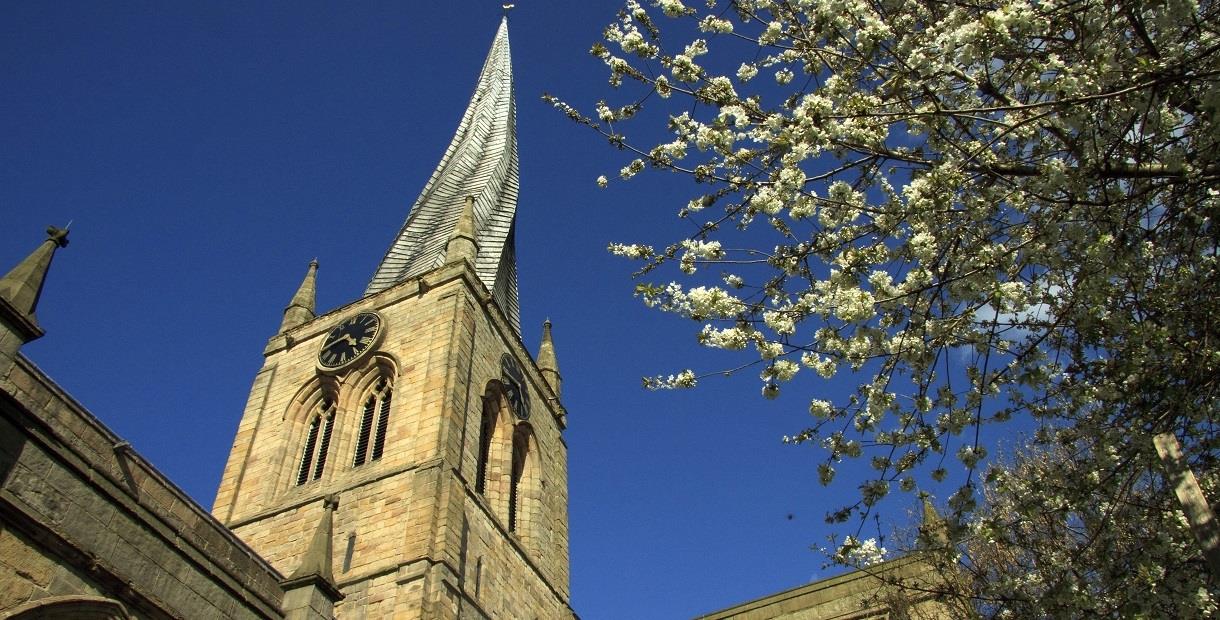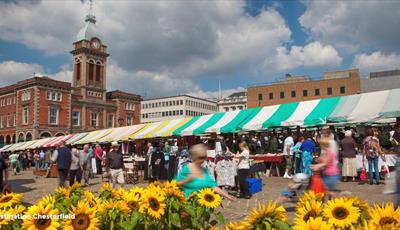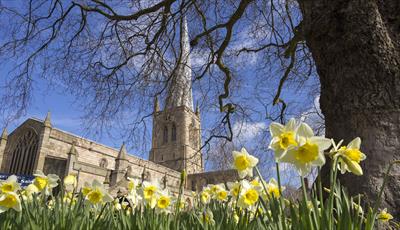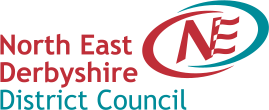Crooked Spire Church
Type:Church
Church Way
Chesterfield
Derbyshire
S40 1XJ
About
The 'Crooked Spire' is Chesterfield's best-known landmark.
You might have seen photographs of it before, or even caught sight of it from the train, or from your car. Maybe you already know that it's 228 feet high, and that it 'leans' 9 feet 6 inches from its true centre.
Even knowing all this doesn't prepare you for walking down High Street and finding yourself in its shadow. The hardest thing to deal with, though, is seeing all those shoppers cheerfully walking about – without even noticing it!
Take a trip up the tower and see Chesterfield from up high, tower tours take place from Easter to Christmas. Please check the website for up-to-date information.
The Spire has been crooked for so long that local people don't spare it a thought any longer, but it stands on the skyline like a question mark – how did it happen?
There are spires in Europe which were deliberately built with a twist, but Chesterfield's Spire started its life straight. History is silent about when it began to lean. We do know that it's still moving but, don't worry, it's not about to fall down, even though the only thing that holds the Spire on top of the Tower is its own weight – that's around 150 tons of wood and more than 30 tons of lead!
So how did it happen? Legend tells of a powerful and evil wizard who tricked the Bolsover blacksmith into shoeing the Devil. Shaking in terror, the poor man drove a nail into the Devil's foot. Screaming with rage and pain, the Devil took flight towards Chesterfield. Skimming over the Church, he lashed out in agony, caught the Spire, and twisted it out of shape.
But the most popular story about the Spire is that it was so amazed to hear of a virgin being married in the Church that it twisted round to try and see such a wonder for itself. It's said that, should the same thing happen again, the Spire will straighten up…
Then, of course, there is the truth – or at least the best guess. The Spire was originally covered in wooden shingles set on a wooden frame. Unfortunately, wood doesn’t last forever and, when the wooden shingles needed to be replaced, lead was chosen as a more hard-wearing alternative. There were some advantages to this. Lead was plentiful in the Peak District so was easy to find and relatively cheap.
There were, of course, some disadvantages. Firstly, the weight – around 32 tons of lead tiles cover the wooden framework of the Spire that was never designed to take this that much weight. Secondly, lead is a metal and it expands when it gets hot and contracts as it cools. One side the Spire faces south, so gets the sun all day, while the north facing side gets hardly any direct sunlight. The south facing lead tiles expand more than the north facing and this continual expansion and contraction at different rates has caused the Spire to twist.
As well as this, there's no cross bracing in the 8 sides of the Spire. Add to that 600 years of weather and, according to one 'expert', bell ringing, and you get a Crooked Spire!
St Mary and All Saints Church is so big that it's often mistaken for a cathedral and, in fact, it’s the largest church in Derbyshire.
The old marketplace was much closer to the Church in the Middle Ages, and it wasn't unusual for the nave to be used as a temporary store. This is why, in May 1266, at the height of the Battle of Chesterfield, we find the Earl of Derby hiding among the wool sacks in the Church. Sadly, for the Earl, he was found and sent to London to face King Henry III.
The Church survived the Battle of Chesterfield and, later, the Civil War and the bombing raids of World War II, but it faced its greatest danger at 9am on 22 December 1961. Fire broke out in the north transept and flames roared through the building to threaten the Spire itself. Within minutes the roads were packed with fire engines and equipment. Church officials and clergy braved the heat and choking smoke to rescue sacred figurines, church treasures and parish registers from the flames.
The blaze was finally stopped in the Tower, just 2 or 3 minutes from taking the Spire, and the cost of the damage came to £30,000. But, a few days later, the bells rang out for Christmas and a service was filmed for TV on 7 January 1962.
The Church, along with its Spire, had weathered the storm to remain the symbol of Chesterfield.
Awards
- Other Awards
 Self-assessed Accessibility Information
Self-assessed Accessibility Information
Facilities
Accessibility
- Disabled access - Access for wheelchair users to the Church but not the Tower
- Facilities for hearing impaired
Catering
- On-site light refreshments
Children
- Children welcome
Parking
- Parking with charge - Town centre car parks nearby
Property Facilities
- Dogs not accepted (except guidedogs)
- Gift shop
- Smoking not allowed
Target Markets
- Accepts groups
- Coach parties accepted
TripAdvisor

- Excellent475
- Very Good216
- Average32
- Poor2
- Terrible0
Map & Directions
Road Directions
The Crooked Spire Church is in Chesterfield town centre but has no car park of its own so the directions below are to the nearest town centre car park.
From North/South - leave M1 at junction 29 and follow A617 to Chesterfield (approx 4 miles). At traffic light controlled roundabout select middle lane and take 3rd exit. At next roundabout select right lane and take 2nd exit (Lordsmill Street). Select right lane and go straight on. At traffic lights turn right (Spa Lane), take 1st left and left again into St Mary's Gate car park.
From East - follow A617 to junction with M1 motorway, then follow route from North/South.
From West - follow A619 to Chesterfield. At traffic light controlled roundabout (Matalan) select middle lane and take 3rd exit. Keep in left lane and, at traffic lights, go straight on. At next roundabout select left lane and take 1st exit (Lordsmill Street), then follow route from North/South for either multi-storey or surface car parks.
Public Transport Directions
Nearest train station Chesterfield, 10 minutes walk away
Any bus to Chesterfield town centre
.png)



















